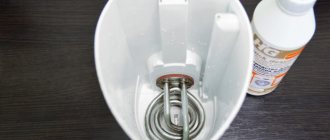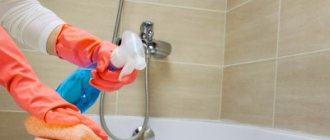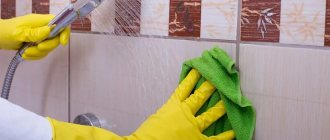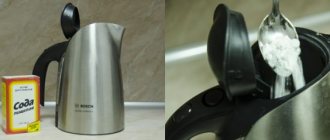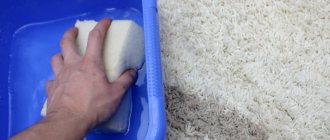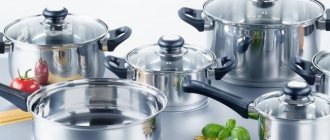How to clean a plastic colander?
Laundry soap. It is necessary to cut it with a knife or grate it and mix it with warm water until a paste forms. This substance is applied to the contaminated area and left for half an hour. After this time, the stain must be wiped off with a sponge (hard side).
Interesting materials:
How to propagate honeysuckle from a bush? How to disassemble a sofa book? How to allow access to all users? How to allow the game to access the network? How to straighten a leather jacket? How to destroy an apple tree stump? How to dilute bcaa powder? How to dilute Ezhemalina? How to propagate blackberries using cuttings? How to dilute Kormilak?
How to Clean Metal Strainers and Sieves
1.Ammonia and warm water
The amount of these ingredients is very arbitrary. Approximately 5 teaspoons of alcohol (ammonia) per 220-250 ml of water. Please note again - it’s warm. Even closer to hot.
Immerse the strainer in the solution and leave for at least 25 minutes. It may take half an hour, or even more. The most crucial moment begins when soaking softens dried food remains. vigorously with a coarse brush or sponge.
2.Brushes
It is difficult to imagine a solution to this problem without the fate of brushes. The stiffer their stubble, the better. The optimal pile length is from 3.5 to 5 mm. Preference for elastic polymer fibers. Natural hair tends to lose its shape, and it is rarely stiff.
The thought of using a toothbrush often comes to mind. The idea is constructive, but mainly in relation to sieves with large holes, through which such long bristles penetrate without much difficulty with vigorous pressure.
3.Dissolving gels
Among modern detergents there are many gel-type ones. They are designed to combat old, thick formations of kitchen fats and technical lubricants. Take advantage of this convenient solution.
Bottles usually have a dispenser and a brush for application. Thanks to this, the use of household chemicals is safe. The main thing is to leave the greased sieves and strainers for a long time so that the substances do a good job of breaking down. Wash off the residue with a firm stream of warm water.
4. Colander into a large hole
This element of kitchen utensils has the same goals as sieves with wire cloth - to separate, that is, to separate. Pasta from water, berries from compote. And so on. Automatically, a colander is often called a sieve.
However, the cleaning problem is much easier to solve since the holes are much larger. First, wash with hot water and soapy suds. Where there are stuck particles of fat and food, a sharpened wooden match or toothpick will help.
5.Oak bark, heating and acid treatment
Before starting mechanical cleaning, heat a strainer or sieve using steam from a hot decoction of oak bark in a small bowl. The same effect is obtained using a slightly heated oven (90-100 degrees). Duration of treatment is 7-15 minutes (depending on the degree of contamination and old age of the dirt).
Be careful when handling plastic parts - holders and handles. Wrap them in a clean kitchen towel to prevent them from melting when the strainer heats up. Remove the kitchen utensil from the oven and, while it is still hot, treat it with acetic acid using a brush and rinse thoroughly under running cold water.
Can the teapot be washed in the dishwasher?
Washing dishes in the dishwasher is simple and convenient. Is it possible to wash a teapot in it? There are various options for kettles, most of which are not recommended for dishwasher cleaning. Such washing can ruin the teapot forever. You should read the instructions for the kettle before putting it in the washing machine. It’s better to spend a little time and wash the kettle by hand.
Advantages and disadvantages
The characteristics of a tea strainer depend on its type, so the pros and cons of different accessories may vary. The main advantage of these products when brewing tea in ordinary (traditional) teapots is the convenience of separating the tea leaves from the drink.
There are sieves that allow you to brew a certain amount of tea in a mug at once - this is also convenient. The main disadvantage of almost all such accessories is the difficulty of removing tea leaves. You also often have to clean the strainer from tea deposits, which takes a lot of effort and time.
The process of brewing fragrant herbal tea using a portioned strainer, as well as the advantages of using it, is described in this video:
Why you shouldn't brew tea without a strainer
Of course, you can brew tea without a strainer. However, this accessory makes the process of preparing a drink more convenient. Also, many types of tea require a certain brewing time; if the tea leaves fall into the mug along with the drink, this requirement is not met. As a result, the quality of the brewed tea may deteriorate. It turns out to be too strong. Therefore, it is better to brew tea with a sieve.
Using a tea strainer is not only convenient, but also interesting, because... Today, stores sell a lot of accessories of various unusual and cool shapes. The main thing is to choose high-quality products that will bring only joy to the owner, and not unnecessary unpleasant troubles.
Instructions for descaling different types of coffee makers
The method for descaling a coffee maker depends on the design of the device. Machines with a removable filter and brewing unit can be easily washed under the tap in running water. If you regularly wash the device after making coffee, then thorough cleaning with citric acid or store-bought tablets can be done no more than once a month.
Models with a built-in unit often have an auto-cleaning (decalcification) function, and if it is not provided, the scale is removed independently using a cleaning solution.
Most modern products are based on citric acid.
Descaling a drip coffee maker
- Wash the filter with warm water and a soft brush (unnecessary toothbrush) and return it to its place.
- Prepare a working liquid from citric acid: dissolve 30 g of crystalline powder in 4 glasses of warm water.
- Pour the solution into the water tank. Add cold water to the tank up to the Max mark.
- Turn on the coffee maker for 5-10 minutes. After 30 minutes, repeat the procedure and wait until the entire solution passes into the receiving flask.
- If there are still traces of scale on the filter, dip it in a hot solution prepared in the indicated way and hold for an hour.
- Rinse the filter well and replace it.
- Run clean water through the coffee maker several times until the acid comes out completely.
Citric acid can be replaced with vinegar. To do this, use white table vinegar with a strength of 9%, dissolved in water in a ratio of 1:2.
If the glass vessel for collecting the finished coffee becomes cloudy, you need to fill it with a warm solution and rinse thoroughly after 30 minutes with water.
Descaling carob, pod and capsule coffee makers
The operating principle of these types of coffee makers is almost the same, the only difference is in the design of the receiving device for coffee powder. Therefore, the descaling methods are the same:
- Unplug the coffee maker.
- Remove used coffee from the horn (holder).
- Wash the removable reservoir under running water and fill it with a solution of the product prepared according to the manufacturer’s instructions, or a solution of citric acid (according to the recipe described above). Allow the working solution to act for 15–20 minutes.
- Empty the pulp container.
- Empty the water from the drip tray.
- Turn on the coffee maker.
- Release approximately half of the heated solution through the cappuccino maker nozzle, turning on the steam mode.
- Pass the remaining solution through the empty horn (capsule holder) in the coffee preparation mode.
How to clean a cast iron kettle?
How to clean a kettle
- You need to prepare table vinegar 6–9%.
- Fill the container three-quarters full with water.
- Bring water to a boil and turn off.
- Pour in the vinegar solution in the amount of the missing quarter of the kettle's volume.
- Leave for eight hours or leave overnight.
Interesting materials:
Which dough makes pizza taste better? At what level does Tom appear in Hay Day? Should you give your cat grass? Do you need to study mathematics? Do I need to add onions? Where does a typhoon come from? Where will trains to Crimea go from? Where did Dumbledore get the Resurrection Stone? Where is John Cena from? Where is Cardi B from?
Causes of scale
The cause of limescale is the hardness salts CaCO3 and MgCO3 (salts of rare earth metals calcium and magnesium) that are poorly soluble in water. These compounds are formed by heating bicarbonates Ca(HCO3)2 and Mg(HCO3)2, which are part of natural water and decompose at temperatures above +40 ºС.
If you install an ion exchange filter or a device that magnetizes water on the incoming water pipe, you can significantly reduce the deposition of hardness salts on heaters and extend the service life of not only the coffee maker, but also the boiler, kettle, washing machine and dishwasher.
Yellow spots on plastic
Windows, which are popular nowadays and made of such durable and easy-to-clean material, unfortunately, quickly lose their color. The reason for this is:
- ultraviolet influence of direct sunlight, which affects the material at the molecular level;
- temperature fluctuations due to weather or radiator operation;
- various impurities that react unpredictably to cleaning products.
We invite you to familiarize yourself with Toy storage: ideas, photos, boxes for toys in your own way
The following will help to return the white color: hydrogen peroxide, a solution with bleach, car cosmetics, wipes for the care of computer equipment and other products described in the article.
Methods for removing rust from pans
Of course, it is easier to prevent this phenomenon, which is detrimental to the pan, than to eliminate it in the future. To do this, you need to systematically clean the dishes. If trouble does happen, then it’s worth knowing the basic methods of dealing with rust on a pan.
- Soda. Every housewife has this bulk substance in her house. You just need to take a small container and heat (or pour warm) water into it. Then add soda. Volumes are based on how much surface area is to be treated. The main point is that you need to get a thick paste. Next, using the abrasive side of the sponge, the paste is applied to the rust or simply the surface that needs cleaning. When the soda is applied, you should let the pan sit for 5 minutes, and then you need to rinse the dishes. Do not rub soda too hard to protect the pan from scratches.
- Salt and lemon. Few people know about this method, but the technique provides positive results. What is required? One lemon and coarse salt. The fruit is cut into two equal parts. The pulp is sprinkled with salt. Lemon acts as an abrasive sponge, and coarse salt is good for cleaning rust. As in the first case, after application you need to let the pan “simmer” for 5 minutes, and then rinse it and dry it. The good thing about this technique is that it does not require large financial costs. If the salt has darkened, add some fresh salt to remove all the rust.
- In difficult cases, you will need lemon juice, foil and white vinegar. The foil is cut into small strips (3 cm), and then carefully rolled into balls. The latter are immersed in lemon juice, and then the rust is rubbed off with them. The effect will be noticeable quickly. Sometimes you will need to lower the pan into a container of white vinegar. However, this is not very convenient, so the second stage is more often used for cutlery. Use balls of foil dipped in lemon juice to scrub the pans.
- Potato scrub is popular as a means to rid pans of rust. Just cut the potato in half. Place a little baking soda on the cut. Sometimes they do without it, but take into account the nuance. If the potatoes begin to slip, simply cut off a little of the top layer. The work is carried out until the rust is removed. However, as practice shows, this technique is suitable for removing thin deposits and shallow layers of rust. If the pots are expensive, then it is better to exclude soda. Enough potatoes. You just have to work, taking several approaches. Then it is possible to clean the surfaces of the pans from plaque and even thin layers of corrosion.
- A kitchen scraper can help remove individual rust stains. It is enough to apply a little dishwashing detergent on it to get a good result. Firstly, this softens the scraping. Secondly, the detergent is a good help for effectively removing rust. Some people use baking soda, but it can scratch the surface in tandem with the scraper. It is better to leave the baking soda for the abrasive side of the sponge.
White
Recipe. Concentrated white is poured into the flask and left for several hours. Afterwards, rinse thoroughly with plenty of warm water.
Reality. A method for real extreme sports enthusiasts. Whiteness does not remove stains from tea in a thermos. And it doesn't even dissolve. It just discolors it. And the unpleasant odor will remain for a long time. Do you like white-scented tea? Then feel free to adopt this method.
What to do. Leave the white for other purposes. Or at least rinse the thermos thoroughly with cold water instead of warm. This will make the smell of chlorine disappear much faster.
Signs of a clogged coffee maker
When using water containing hardness salts, scale will inevitably form in the coffee maker. Both simple drip and capsule or carob coffee makers are susceptible to clogging.
The more bends and smaller the diameter of the tubes for the passage of water in the coffee maker, the greater the likelihood of scale formation. Lime scale particles clog water flow channels.
Not all coffee makers are equipped with a built-in indicator (a counter for the number of cups of coffee brewed), so you need to be able to recognize signs of limescale deposits inside the machine:
- It takes longer to prepare one serving of drink than before;
- if the tube and outlet are clogged, the stream of ready-made coffee becomes thin, causing the cup to take longer to fill;
- the taste of the drink has deteriorated;
- there is a foreign smell;
- the operating device began to make unusual sounds;
- a light gray sediment is visible in the cup;
- Electricity consumption has increased while the coffee maker is operating.
Professional and folk remedies for cleaning coffee makers
Coffee machine manufacturers have long created a separate source of income for themselves: they produce and sell products for descaling devices. The latest generation models have an auto-cleaning function with the obligatory use of a proprietary product. After brewing 200-300 cups of coffee, the smart unit signals that it's time to clean. Professional products are produced in the form of tablets, powders and liquids.
Each coffee machine manufacturer claims that only branded products can be used. This is nothing more than a marketing ploy. If you read the ingredients on the label, it becomes clear that the main component is citric acid. Is it worth spending a lot of money (from 1000 to 1200 rubles) on purchasing a branded product when a packet of citric acid costs several times less and is sold in any grocery store?
Using food-grade citric acid to descale a coffee maker has a number of advantages:
- citric acid does not cause environmental pollution and does not release toxins;
- the process of dissolving limescale formations occurs gently, without releasing hazardous chemicals harmful to health;
- To dissolve even long-standing formations, you need a small amount of acid in the form of crystalline powder (30 g per 1 liter of water).
How to remove scale from a kettle?
Cleaning neglected surfaces
- into the kettle
. - Add 1 tablespoon of baking soda powder.
- The resulting solution is brought to a boil and the water is drained.
- Then pour 1 tablespoon of lemon water.
- Again, the solution is simmered over low heat for 30 minutes.
Interesting materials:
When does a lemon from a seed bear fruit? When does medlar bear fruit? When does the nut bear fruit? When to feed Broilers meat and bone meal? When to give Mash to chickens? When to give chickens eggshells? When does the Decembrist pick up buds? When is the cheapest time to install an air conditioner? When do wild ducks start laying eggs? When to add Algaecide to the pool?
Getting rid of fungal formations
If the thermos is stored closed for a long time, mold may form inside. Fungus is one of the most unpleasant and difficult to remove types of stains. You can remove fungus in thermal containers using household chemicals.
There are many dishwasher cleaning tablets and gels on the market. Such products will help get rid of fungal formations in the thermos. But please note that this method is not suitable for all thermal cookware. This method should be used extremely carefully and only in case of urgent need.
When using this method to remove mold, there is no need to subject the inside of the flask to additional mechanical stress. In other words, you should not rub the inside of the thermos with a brush or brush.
After treating the dishes with a cleaning agent, they must be repeatedly doused with boiling water and rinsed thoroughly.
To avoid further formation of fungus inside the flask, the thermos must be thoroughly washed and dried well after each use. Thermal containers should only be stored open.
To prevent the formation of tea deposits and unpleasant odors from food in a stainless steel thermos, such a product must be regularly looked after. After each use, the thermal cookware, flask and lid must be thoroughly washed. This product can be washed with regular soap solution or dishwashing gel.
You can wash tea from the teapot in the dishwasher; to do this, place the teapot in the machine, add detergent (this can be a special tablet detergent or a detergent in the form of a powder or liquid). Set the required temperature, and in the end you will get a clean kettle without unpleasant tea residue.
For manual cleaning, you can use either liquid dishwashing detergent or powder detergent, but it does not contain abrasives so as not to scratch the surface of the kettle.
You can wash tea with special chlorine-containing products. To do this, apply a small amount of the product to a sponge, thoroughly clean the outer and inner surfaces of the kettle, leave the product for 10 - 15 minutes, then rinse under running water.
Causes of scale
The cause of limescale is the hardness salts CaCO3 and MgCO3 (salts of rare earth metals calcium and magnesium) that are poorly soluble in water. These compounds are formed by heating bicarbonates Ca(HCO3)2 and Mg(HCO3)2, which are part of natural water and decompose at temperatures above +40 ºС.
If you install an ion exchange filter or a device that magnetizes water on the incoming water pipe, you can significantly reduce the deposition of hardness salts on heaters and extend the service life of not only the coffee maker, but also the boiler, kettle, washing machine and dishwasher.
Professional and folk remedies for cleaning coffee makers
Coffee machine manufacturers have long created a separate source of income for themselves: they produce and sell products for descaling devices. The latest generation models have an auto-cleaning function with the obligatory use of a proprietary product. After brewing 200-300 cups of coffee, the smart unit signals that it's time to clean. Professional products are produced in the form of tablets, powders and liquids.
Each coffee machine manufacturer claims that only branded products can be used. This is nothing more than a marketing ploy. If you read the ingredients on the label, it becomes clear that the main component is citric acid. Is it worth spending a lot of money (from 1000 to 1200 rubles) on purchasing a branded product when a packet of citric acid costs several times less and is sold in any grocery store?
Using food-grade citric acid to descale a coffee maker has a number of advantages:
- citric acid does not cause environmental pollution and does not release toxins;
- the process of dissolving limescale formations occurs gently, without releasing hazardous chemicals harmful to health;
- To dissolve even long-standing formations, you need a small amount of acid in the form of crystalline powder (30 g per 1 liter of water).
Vinegar
Recipe. Pour boiling water into a thermos, add 1 tbsp. l. vinegar essence. Leave overnight. In the morning, rinse thoroughly with water.
Reality. The method works very well. True, instead of a mixture with acid, you can simply pour 3 or 6% vinegar into the flask. Then you definitely can’t make a mistake with the concentration, because the volumes of thermoses are different for everyone.
What to do. You don't have to leave the liquid inside for the whole night. An hour's treatment will be enough. For greater effect, do not add acid to the very top. Leave about a third of the volume free, throw a small piece of hard sponge inside. Then screw on the cap and shake.
And don't be afraid of the unpleasant pungent odor. If you rinse the flask thoroughly and then dry it open, the aroma of the vinegar will quickly dissipate.
What to do if you can’t remove stains
Cases where stains cannot be removed are quite common. Then it will be possible to find another use for plastic containers - not food. For example, they are perfect for storing materials used for creativity. The most important thing is that there are no grease stains. You can store a variety of small items in them - nails, screws, small toys, spice bags, etc. As a last resort, you can throw it away - the products are reasonably priced, and anyone can afford to buy a new plastic container. They are sold almost everywhere.
Vinegar and soda
Recipe. Pour 3% vinegar into the flask, add 3 tbsp. l. baking soda. Leave overnight, then rinse with clean water.
Reality. The advice was clearly coming from a man who had never made his own pop as a child. These two substances, reacting with each other, are completely neutralized. And why hold out on an absolutely useless liquid all night? And there are plenty of sources that rewrite this recommendation word for word, without even thinking about it. Plus, there is no warning anywhere about the strength of the reaction. It’s not enough to put a thermos in the sink, you need to put it in the bath! Because the dirty foam comes out like a fountain.
What to do. Choose one thing. Or clean the thermos with vinegar or any soda. Mixing these two components is only a transfer of time and money. Or make yourself some fizz already!
Varieties
Nowadays, a large number of types of strainers have appeared. They all differ in material, shape, color.
The main materials used for the purpose of producing tea infuser are stainless steel and silver. However, they have a competitor - silicone, which has a number of valuable properties:
- The shape of the silicone product does not change over time.
- This material is heat-resistant.
- A high-quality product does not harm the human body.
- Silicone is very flexible, so it can be molded into different shapes.
A silver tea accessory can act as a gift for a loved one. This metal has a bactericidal effect, which increases the benefits of tea. The silver sieve also does not change its properties over time.
Experiment result
So, what we have is a strainer from a teapot, covered with a layer of coloring pigment - tannin. You need to clean it in the least expensive way. There are a number of tips, I try to use them until I get results. Let's start by boiling in a steep solution of table salt.
There is practically no effect, either the advice is wrong, or the case is too advanced. Maybe other advice from the same area? I'm trying to turn on my brain. Since the strainer will be used in the future for making tea, it means that you should not use heavy chemicals to avoid consequences.
Therefore, next in line will be baking soda. I take a strainer, lower it into a mug, pour in about 700 ml of water and add baking soda - three heaped teaspoons. I put it on gas and heat it up. After ten minutes of boiling, the water became blacker than the tea leaves, and the sieve removed from the water was covered with black grains, reminiscent of coffee grounds.
I rinse everything, clean off the grounds and set it to boil again, pouring clean water and adding the same portion of soda. 15 minutes of boiling and an almost clean sieve is removed from the water. All that remains is to lightly brush it and the result is obvious.
Only the bottom of the strainer is not completely cleaned; perhaps a more vigorous cleaning agent is needed to clean it? But this will remain until next time, but for now the resulting option suits me quite well.
The original cleaning method can be seen by watching the video. But this is already the use of heavy chemistry.
Having learned how to clean the strainer, you just need to remember to repeat this procedure regularly to avoid blockages and the appearance of dark spots. I hope that now there will be significantly fewer questions about how to clean a teapot.
The stainless steel inside the thermos easily absorbs various odors; it is also susceptible to the formation of deposits from tea or coffee. Contamination makes storing drinks and food in these containers almost impossible. Scale, deposits from drinks and an unpleasant ingrained odor will spoil the taste of the food. It is important to know how to clean the inside of a stainless steel thermos without damaging the surface of the product and extending its service life.
Why cleaning is necessary
It is this strainer that becomes so clogged with tannin, the coloring pigment contained in tea, that even systematic rinsing after each brew will not help cope with this problem. Therefore, a brown coating forms on the nose and inner walls.
Why do you have to wash the strainer - simply because the holes in it become so clogged that the sieve completely stops letting the tea leaves pass through it.
Of course, as an alternative, they may suggest using disposable tea bags for brewing, but for the most part their quality leaves much to be desired, since they mainly contain tea production waste, and not full-fledged tea.
